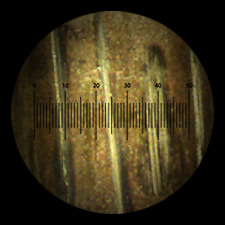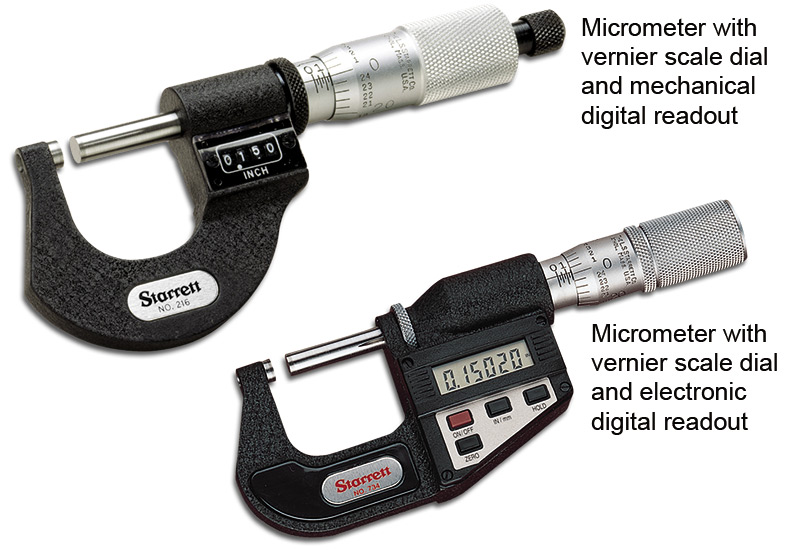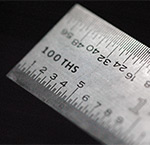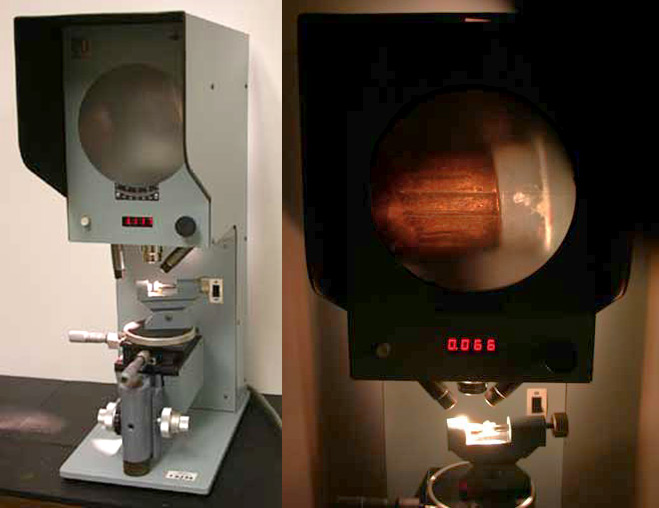Home | Glossary | Resources | Help | Contact Us | Course Map
Archival Notice
This is an archive page that is no longer being updated. It may contain outdated information and links may no longer function as originally intended.
Dimensional Data and Measurement Tools
Accurate dimensional measurements are essential in documenting many class characteristics of firearm/toolmark evidence. Until recently, scientific measurements were usually taken using a graphic analog format with a continuous display. Common examples include clocks (with hands), speedometers (with needles), and thermometers (containing an expanding fluid). Measuring tools provided analog readouts, such as the dial register on calipers and the vernier scale on micrometers. Today, these forms of measurement are being replaced by digital displays.
The instruments commonly used by examiners to gather dimensional data today include the following:
- Glass measuring reticule
- Electronic reticule
- Digital measuring equipment and software
- Micrometer
- Calipers
- Machinists scale
- MP6 optical projector
Glass Measuring Reticules
Measuring reticule accessories have been available for many decades. They are compatible with microscope eyepieces, or may be integral parts of an eyepiece micrometer. These glass reticules are easily put in place by insertion into a reticule holder on the underside of an adjustable stereomicroscope eyepiece. Reticules can be provided in a variety of standard measurement divisions (such as inches or millimeters), as needed. It is important to note that both eyepieces of a stereo microscope must be adjustable to use this technique. Calibration must be carried out using a stage micrometer, which is a glass slide with known divisions for use as a standard.
Filar Micrometer Eyepieces
A filar micrometer eyepiece is a specialized optical instrument for taking linear measurements directly through a microscope. (The word filar is derived from the Latin word filum , or thread.) The micrometer eyepiece is substituted for a standard eyepiece on stereo and comparison microscopes and is used to measure the widths of land and groove impressions in fired bullets and small evidence items.
The filar micrometer eyepiece is an optical-mechanical system, which includes several components:
- A tube to replace a standard microscope eyepiece
- A focusable eyepiece
- A stationary optical scale inserted within the eyepiece to optically anchor on a point to be measured
- A movable optical hairline or thread within the field of view superimposed on the stationary standard
- A manual micrometer screw which moves the optical hairline from starting to end point of the item being measured, with an analog vernier scale for reading results
Digital filar eyepieces translate the mechanical movement of the optical hairline into a digital readout. A specialized processor is required and costs ten to fifteen times as much as manual calculation.
Electronic Reticules
Electronic reticules for stereomicroscopes are a recent addition to the measuring equipment available to forensic examiners. They combine a stereomicroscope, a digital camera, and a computer. Live images are displayed on-screen with a choice of measuring grid (electronic reticule) overlays, providing a convenient method for taking and comparing measurements. The software saves and exports the image data for use in case documentation.
Eyepiece Measuring Reticules
Older comparison microscopes may be fitted with glass eyepiece reticules. It is difficult to find appropriate glass reticules for these microscopes because neither the microscopes nor the reticules are being manufactured.
Digital Measuring Equipment
This new generation of comparison microscopes offers two major options for taking and recording measurements:
- Electronic reticules similar to those available for stereo microscopes (see previous page)
- Mouse-driven point-to-point techniques displayed on-screen (proprietary in nature and software dependent)
The accompanying software provides options for saving, storage, and retrieval.
Micrometer
The micrometer is a measuring tool frequently used in firearm/toolmark examinations for measuring class characteristics such as thickness, width, or diameter. The device consists of an outer thimble and inner spindle joined by a fine pitch screw mechanism. On older analog or mechanical models, measurements are read with a vernier scale or a mechanical digital readout. The modern micrometer has an electronic display that has nearly replaced the older versions.
Read more about using micrometers in Module 10.
The electronic models
- are easy to use,
- are easily zeroed at any point,
- offer a choice of units, usually English and metric,
- are designed for analog use in the event of battery failure,
- are accurate,
- provide easy to read liquid crystal displays (LCD).
Read more about how to use the older analog micrometers.
Other Equipment
Calipers
Calipers are used to measure the distance between two opposing sides of an object. It may be an inner dimension (such as the diameter of a hole) or an external diameter (such as the thickness of an object). The analog versions of calipers have a continuous dial with a needle from which to read results; digital versions provide an LCD display. Digital calipers also have a scale for manual use in the event of battery failure.
Steel Machinists Scale
For general utility, the use of a simple six-inch steel machinists scale can be helpful in making some types of measurements, such as barrel length. It is most useful if it has both English and metric units. The English units should include tenths of an inch as well as the standard increments.
MP 6 Optical Projector
Although this optical projector was designed in the 1970s for measuring land and groove impressions, it can also be used for measuring bullet diameter and other small items. The first production model was used to support the FBI Laboratory in the massive data input phase in the assembly of the general rifling characteristics file. Although no longer manufactured, these are still in use.
Additional Online Courses
- What Every First Responding Officer Should Know About DNA Evidence
- Collecting DNA Evidence at Property Crime Scenes
- DNA – A Prosecutor’s Practice Notebook
- Crime Scene and DNA Basics
- Laboratory Safety Programs
- DNA Amplification
- Population Genetics and Statistics
- Non-STR DNA Markers: SNPs, Y-STRs, LCN and mtDNA
- Firearms Examiner Training
- Forensic DNA Education for Law Enforcement Decisionmakers
- What Every Investigator and Evidence Technician Should Know About DNA Evidence
- Principles of Forensic DNA for Officers of the Court
- Law 101: Legal Guide for the Forensic Expert
- Laboratory Orientation and Testing of Body Fluids and Tissues
- DNA Extraction and Quantitation
- STR Data Analysis and Interpretation
- Communication Skills, Report Writing, and Courtroom Testimony
- Español for Law Enforcement
- Amplified DNA Product Separation for Forensic Analysts







